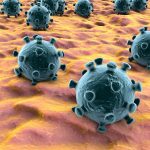Gluten-Free Lyme Whisperer: Interview With Joy Devins, Patient and Advocate
Mark Swanson, ND
This issue of The Expert Report is a refreshing reminder that healing wisdom and learning comes as much from listening to our patients as it does from the science, knowledge, and understanding presented by fellow NDs and colleagues, medical specialists, researchers, and academics. Our special guest is Joy Devins, a New Hampshire resident, naturopathic patient, and health advocate. At age 37 years, she is a vibrant and busy working mother, a runner and athlete, and a nutritionist, and she fills a top executive position with a leading nutritional supplement company. She also faces her own personal health “issues,” namely, the dual conditions of gluten intolerance and Lyme disease. Not surprising, she has met many other fellow “Lymie-Gluts” through her support outreach and blog www.lymewhisperer.com. She knows she is no longer alone or feels isolated. She has found the voices in the dark and as a result has made lasting friendships and close healing bonds.
Through a health partnership with her ND, she has been successful at turning her health crisis into a proactive health challenge that refuses to let her become a victim of her conditions. As a result, she is winning this long battle of endurance and is conquering new heights, and she now offers inspiration and hope for others like her. Joy has agreed to share her patient story and insights on her health and healing journey, with revealing details of her medical history, treatment protocol, and passion for advocacy.
“…I was thankful for all the things it wasn’t….”
What is your secret to staying healthy in the faces of Lyme disease and gluten intolerance?
Positive attitude is number 1; good fortune is number 2. When I was diagnosed with gluten intolerance, I adopted a gluten-free lifestyle from that moment on and never looked back. I never focused on what I couldn’t eat, only on the many things I could. My diet is much more diverse and healthy now, and I don’t miss a thing. I say good fortune because I have been working in the supplement industry for many years, have met many health professionals like yourself, and was very aware and educated on gluten already. Because of these things, it was more or less a seamless transition for me.
Lyme disease—not so seamless. Lyme disease is a debilitating, isolating illness. I spent several years with frightening symptoms and no answers. Once the diagnosis came, I was thankful for all the things it wasn’t, despite the private hell that Lyme disease is. I knew I would be here for my kids, so I was relieved, grateful, and ready to fight. My gluten-free diet, physical activity, and knowledge of and access to all the right supplements has been paramount to my health. I even ran my first 5K for Team Lyme this summer, and I haven’t stopped running since.
What came first, Lyme disease or gluten intolerance?
I can’t be sure. I was diagnosed with gluten intolerance first. In fact, because of some of my Lyme symptoms—tingling and numbness in the hands and feet—I was tested for celiac disease, which was negative, then later tested for gluten intolerance, which came back positive. I adopted the gluten-free lifestyle, but the tingling never went away. Two years later, I was diagnosed with Lyme disease.
“…I had obvious symptoms for 2 years before being diagnosed.”
How long did you have symptoms of each before they were diagnosed?
I have probably been gluten intolerant for most of my life. I’ve had psoriasis since early childhood. As an adult following a gluten-free lifestyle, my psoriasis is mild and at times has been in almost complete remission. Before going gluten-free, it was moderate to severe. Regarding Lyme disease, I had obvious symptoms for 2 years before being diagnosed. Looking back, there are some instances before then that make me wonder if underlying Lyme was to blame, including 2 very difficult pregnancies and recurrent back problems. I never saw a tick and never had a bull’s-eye rash, fever, or joint pain.
Do you recall the tests performed?
I had the genetic test for celiac disease, which was negative. I also had salivary IgG and IgA, which diagnosed the gluten intolerance. Regarding Lyme, I had a Western blot, which was inconclusive, followed by a CD57 count, which was indicative of Lyme disease.
Are you surprised that many others have both Lyme disease and gluten problems?
No, not at all. I have met many fellow “Lymies” through my blog who were diagnosed with Lyme and are now on gluten-free diets. They described their Lyme symptoms as worsening, especially headaches and stomach problems, when exposed to gluten. A number of people indicated that their food issues did not stop with gluten and that they gradually became unable to tolerate other foods as well. I am also the founding member of a Lyme support group in my community. At our last meeting, a participant described experiencing allergies to new foods often, sometimes every 4 to 6 weeks (which coincidentally coincides with the Lyme bacteria life cycle). She has suffered with Lyme disease for 21 years, and her only symptoms have primarily been food allergies. Another member described sinus infections and persistent environmental allergies as her most obvious symptoms.
What are your most common and most bothersome symptoms?
The nerves in my hands and especially my feet are constantly tingling, vibrating, or pricking like pins and needles. I’ve gotten used to feeling like I’m short circuiting. I’m forgetful. I have muscle twitches all over my body. I have vertigo. I’m forgetful. My bladder is inflamed and spasmodic. Did I mention I’m forgetful? I need to write things down everywhere and all the time so I don’t forget them. And I have to push through fatigue every day. But most of all, it’s the back pain. Did I mention forgetful too?
How would you characterize your digestion and GI function before and after being on a gluten-free diet and Lyme therapy?
I was fortunate in that I really didn’t have many GI issues from the gluten intolerance. My issue was mostly my skin, specifically the severity of my psoriasis. With Lyme, however, GI issues consume me at times. First, there’s the antibiotic-associated diarrhea. Second, there’s a recurrent flulike GI distress. I have periods where I don’t experience it, then periods where I experience it every few weeks. It’s hard to say if it’s a Herxheimer reaction from the die-off of treatment or the Lyme itself. Even though the GI issues are bothersome, I tend to worry more about the effect of Lyme on my blood sugar and hormone endocrine function. My fasting blood sugar and progesterone levels are higher now with Lyme than they were before.
How many physicians did you see before you found the right one?
I saw 6 specialists and ended up in the ER. I bounced from one doctor to the next for 2 years. My symptoms were dismissed by my primary care physician and the neurologist as being stress-related, once MS [multiple sclerosis] and a B12 deficiency had been ruled out. The urologist, optometrist, and ob/gyn also found nothing, despite the symptoms that brought me to them. I thought I was dying, and no one could help me—and yes, all the while working and being a mom. Finally, I landed in the hands of a competent Lyme-literate naturopath, one of the smartest and most intuitive people I know.
Can you share some of your naturopathic treatments, a protocol that works for you?
As with the Lyme antibiotics, the herbal or natural protocols change every few weeks or months, as you adapt your protocol to your symptoms, which tend to migrate with the bacteria. In my first year of treatment, I mostly used herbal tinctures containing garlic, licorice, and Uncaria, as an example, to target the bacteria, along with a high-potency probiotic. In my current second year of treatment, I am taking a more potent form of Uncaria extract that’s free of tretracyclic alkaloids (TOA), banderol bark extract, olive leaf extract, and Maitake mushroom to target Lyme. I plan to add Andrographis and resveratrol to this protocol soon. I also take homeopathics to target the coinfection, in my case Bartonella. I also take a teasel root tincture and a greens protein drink for detoxification. Lastly, I take systemic enzymes to help lessen inflammation and as a result some of my symptoms. In addition, I continue to take a high-potency probiotic formula too.
Are you also taking antibiotics for these conditions?
I have been on various combinations of antibiotics for 2 years prescribed by my ND. I currently take azithromycin (500 mg once per day) and minocycline (100 mg twice per day). These target the Lyme bacteria in its spirochete (or spiral) shaped form. In a few months, I will start metronidazole (Flagyl), an antibiotic that goes after Lyme in the cystic form, the form it likes to hide out in. I am hoping to come to an end to my antibiotic therapy within the next 6 months, but it could be another 12 months or more. We may decide that I will never reach a point of being totally Lyme free and discontinue the antibiotic treatment, at which point I’ll maintain a natural protocol, probably for the rest of my life, to keep my health in balance.
“I try to make every day a good day…. I’m just so grateful for the health that I do have.”
Does it cycle in you, with good and bad days?
Again, it mostly all comes back to attitude. I try to make every day a good day, despite it all, except when my bladder acts up! Then there are some definite logistical issues. I’m just so grateful for the health that I do have. I think that the gratitude and inner strength is what people “see” when they tell me I look healthy or good, despite the Lyme. On my “bad” days, I power through fatigue, vertigo, back pain, and brain fog. My symptoms do tend to get worse or change in 4- to 6-week cycles, sometimes longer. Sometimes the worsening of my symptoms coincides with a stressful week, a full moon, or with my menstrual cycle. My symptoms always get worse in the fall and winter, without the summer sun.
“I also have a child with Lyme….”
How do you get through all this mentally and stay motivated to follow your treatment plan?
To push through the physical and mental challenges every day? I’m a warrior for my kids! I want them to have a strong mom and to see me as nothing but. I also have a child with Lyme and need to be a strong role model for him. My 8-year-old is also on azithromycin (200 mg/5 mL once per day) and rifampin (150 mg/5 mL twice per day). He also takes the Uncaria, banderol bark, Maitake, and probiotics. We go to the same ND for our Lyme. He is a hockey and baseball player on top of and despite it!
I have no choice but to be positive and persevering. I am lucky to enjoy my work, my colleagues, and employees, and that gives me purpose every day. They would say I am a productive and effective leader that has risen and continues to rise above this challenge. That motivates me even more. I want to be an inspiration within the Lyme community, for being physically strong and fit. That is also a great source of motivation for me. Lyme has been a horrific journey, but it has also been a blessing. I wouldn’t change anything for the strength I’ve found, the lifestyle changes I’ve made, the prioritizing I’ve done, and the amazing people I’ve met, especially my new Lyme friends.
What can the naturopathic community do to better support individuals dealing with Lyme disease and gluten sensitivities?
NDs can help us have a voice and can be our advocates too. NDs can aspire to be Lyme literate by joining ILADS, the International Lyme and Associated Disease Society. There are so many obstacles, controversies, and dead ends for Lyme sufferers. We need more naturopaths to take a stand for us. This is the epidemic of our time; the stats are out there. I know this to be true firsthand from my blog, www.lymewhisperer.com. I have followers from all over New England and the Northeast US, Pacific Northwest, Missouri, Montana, California, Kentucky, Texas, Florida, Ohio, Virginia, Pennsylvania, and more—internationally, Canada, the UK, the Netherlands, and Australia—all of them suffering with Lyme and many also with gluten intolerance, and so many of them with nowhere to turn medically. In a few short years, I have gone from knowing no one with Lyme to many in my community alone. My doctor’s practice has grown and expanded and moved several times to accommodate the explosion of new cases. I fear that we won’t have the doctors we need to handle this epidemic. We need you! This is my plea.
“The naturopathic community is one of the few trusted places we can turn.”
You have the podium…, and we are listening.
Gluten intolerance will always be a silent struggle, but with diligent gluten avoidance it is quite manageable personally and socially. Chronic Lyme disease is a much greater struggle and needs more understanding, rightful recognition, and medical acceptance. One needs not have had a bull’s-eye rash, fever, or joint pain to be a candidate for Lyme screening, contrary to what some medical establishments believe. The medical community and insurance companies should expect that many months of treatment will be required for chronic Lyme. It’s quite commonly “brushed off” as a psychosomatic illness that “developed” after the initial short-course 30-day antibiotic regimen ends (and fails). So many chronic cases are faced with mounting medical bills for their ongoing IV antibiotic treatments because insurance refused to cover after 30 days. When someone is diagnosed with other chronic illnesses, the medical profession seems more resourceful and supportive. In contrast, a diagnosis of chronic Lyme disease means you are more likely to be shunned and not viewed as being seriously ill. It’s frustrating.
Why was the vaccine pulled so prematurely, and why can’t it be brought back? Why did research at UC [University of California] Berkeley on antiborrelial serum proteins from the western fence lizard stop, without the chance to be developed into a treatment? There are so many unanswered questions, obstacles, controversies, and dead ends for Lyme sufferers. With more help and recognition, we can prevent other people from suffering our same journeys. The naturopathic community is one of the few trusted places we can turn. We need you to take on the challenge of Lyme disease, particularly diagnosing and treating it. That’s how you can help us most.
So when you go to a party, club, or something and see someone eating crackers or pretzels, do you get like all wigged out or stay OK with it and just keep dancing, tingling feet and all?
Ha! The pretzels and dip are hard. Oh my! Just bring on the gluten-free beer!
Dr Swanson’s closing comment:
Thank you, Lyme Whisperer! More than any other healthcare provider, NDs listen most and embrace learning from their patients. Many will strive to meet your plea, even as far away as here in the Northwest and beyond! The late and beloved Dr Bastyr said, “It’s not the doctor that does the healing, it’s the patient.” Joy, your healing journey, with the inspiration and hope it brings to others, is no exception.
 Mark Swanson, ND, writes “The Expert Report” column, which is featured in NDNR. Dr. Swanson has over 25 years experience as chief medical advisor, research and technical consultant, and products formulations expert to leading practitioner brand supplement manufacturers. He is a former associate editor for the American Journal of Naturopathic Medicine, national product director, and published researcher. He is a pioneer graduate of Bastyr University, 1984. Dr. Swanson has his private practice specializing in Preventics Care and Functional Medicine, in Sequim, Washington. Contact: [email protected]
Mark Swanson, ND, writes “The Expert Report” column, which is featured in NDNR. Dr. Swanson has over 25 years experience as chief medical advisor, research and technical consultant, and products formulations expert to leading practitioner brand supplement manufacturers. He is a former associate editor for the American Journal of Naturopathic Medicine, national product director, and published researcher. He is a pioneer graduate of Bastyr University, 1984. Dr. Swanson has his private practice specializing in Preventics Care and Functional Medicine, in Sequim, Washington. Contact: [email protected]









